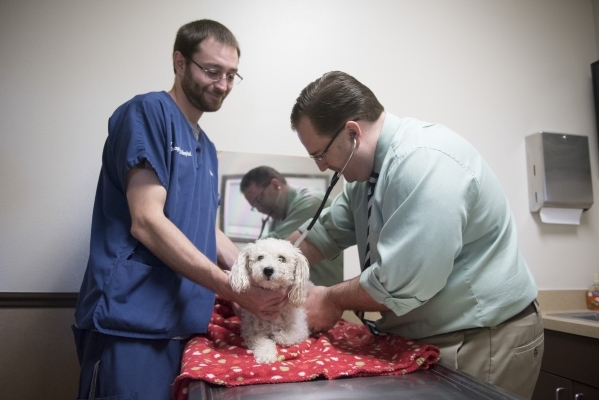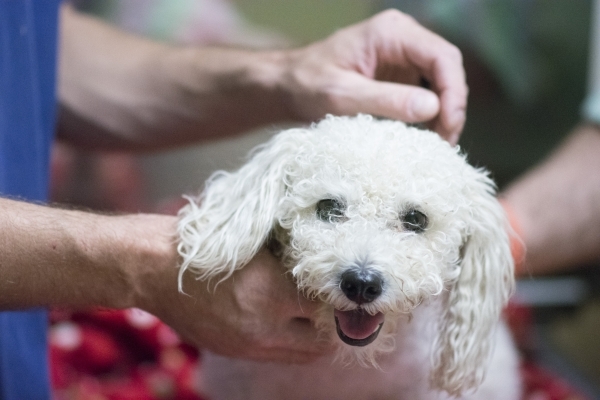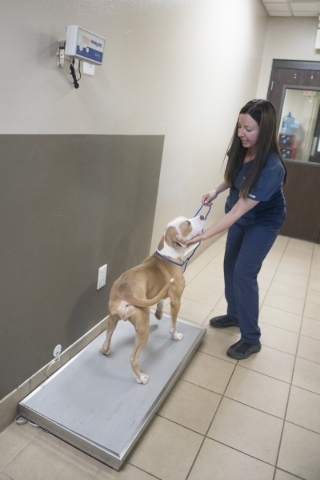Porky pets need diet, exercise, too, for better health
Like many of us, Basurman put on a few extra, unwelcome pounds as middle age began to beckon.
As a result, about a year ago, Basurman went on a diet that has worked out pretty well. He has lost about 25 pounds, is maintaining that weight loss, and even is trying to drop a few more pounds. And for his success, Basurman surely deserves a healthy treat.
Maybe a low-fat, reduced-calorie doggie biscuit. Or a bacon-flavored, but nutritionally sound, little something.
Basurman is a 6-year-old bull terrier, and his battle with creeping poundage isn't uncommon among the dogs and cats with whom we happen to live.
There are studies that indicate that more than 40 percent of Americans' pet dogs and cats suffer from obesity. But, says Dr. Travis McDermott, a veterinarian at Durango Animal Hospital, "I would even say that's on the low side. My guess is the estimate is closer to 60 to 70 percent.
"One big issue we have is the perception of people who come in and say, 'I'm worried that my dog is too skinny,' and the dog is actually the perfect weight. Most people imagine that fat, happy Lab as the way they should be, and it's really not."
Dr. Nichole Wagner, a veterinarian at Mountain Vista Animal Hospital, agrees that "what we see as fluffy and round is actually pretty fat. We should be able to palpate a dog's ribs. They should have that little tuck to their waist. They should look more like an hourglass from the top."
And, McDermott notes, carrying just a few pounds of extra weight can be as significant of a health burden for a cat or dog as for a person.
"People don't realize that a lot of it is scale," McDermott says. "Take a 20-pound dog that is about a tenth of the size of a 200-pound person. Every calorie they eat is like us eating 10 times the calories."
It's not difficult to pack extra pounds onto our pets. For instance, Wagner says, "I think a lot of us treat food like love. So when our pet is looking cute and wanting affection, we give treats instead of pets."
Many of us "also treat them like people," she continues. We share our food, even if it might not be nutritionally sound for them.
Nor, Wagner says, do we think about adjusting our pets' feeding routines to their real lives. "These dogs aren't herding sheep. They're more sedentary, and they get too much."
Ultimately, the dynamics of pet obesity are the same as the dynamics of human obesity: Eating too much and exercising too little. And just as they are in humans, the consequences of obesity can be severe for a pet.
McDermott notes that one study shows that "dogs and cats of proper weight live an average of two years longer than animals that are overweight."
In the meantime, obese dogs and cats suffer from health problems that, McDermott says, can include type 2 diabetes in cats, joint problems, high blood pressure, and pets that "are overall just not as healthy and don't live as long."
Vladimir Fridman, Basurman's owner, says Basurman hit 90 pounds at the apex of his obesity battle, "and that's huge for this breed. We tried different things. We tried exercise, we tried to control his diet, and it didn't work."
Basurman began gaining weight about three years ago. Fridman says the dog's behavior changed, with Basurman becoming more sedentary. Possibly complicating things was that Basurman loved playing in grass but turned out to be allergic to it, which made outdoor exercise difficult, and he also has an apparent allergy to chicken, which complicated creating a healthy diet.
But, Fridman adds, "I don't know what to say. I really feel like it was our fault feeding him, or just giving him too much treats and stuff. But when he gained the weight in the first place, it was really hard to keep it under control."
For the past year, Basurman has been eating prescription dog food formulated specifically for weight loss.
"Now, he's like 65 pounds. So he lost 25 pounds," Fridman says. "He is more active, he looks great, he's way healthier than he was before."
Jason Egan put Gizmo, his 4-year-old long-haired chihuahua, on a diet about six months ago. Gizmo weighs about 8.75 pounds but should weigh about 6.75 pounds, Egan says, "and two pounds might not sound like much, but when you're dealing with such a small animal, it is."
Egan, owner of Fright Dome at Circus Circus and a board member of the Nevada Society for the Prevention of Cruelty to Animals, has discovered that "it's very hard" for a pet to lose weight.
"I'm not a vet by any means, but I know it's a problem we fight," he says. "And living in Las Vegas is an issue, too, because when you've got a small dog with short, little legs and it's 115 outside, it's difficult to exercise them. They can burn their paws, and heat can do a number of things."
Gizmo now eats a special diet, exercises more and naps less. But, Egan says, "it's a slow process."
Dietary changes for pet obesity typically begin with eliminating table scraps and other human foods from a dog's or cat's diet. Then, the pets may be fed specialized food formulated to meet specific nutritional needs.
A veterinarian can design nutritional weight-loss programs that will offer a pet proper nutrition for different stages of its life while still promoting safe weight loss.
There is "a lot of marketing" in pet foods, McDermott adds, and "one of the biggest things we deal with is counseling people on what options there are out there."
"There are some good over-the-counter weight management foods," Wagner says. "But in those extreme cases, we have prescription diets that are very low in calories and fat but have the nutrients they need. If you just cut back feedings (of regular food), they're not going to get the nutrients they need. So you can't just eliminate food."
Then, a pet's weight loss regimen may include ways that a pet can be encouraged to become more active and less sedentary. For a dog, that might mean walks or dog park visits. For cats, it might include ways to encourage jumping, playing and moving in the house.
"Just toys," McDermott says. "That little feather on the end of a stick sounds funny, or a laser pointer sounds hokey, but it actually works to get them up and moving."
And if all that sounds like a burden on the pet owner, it seems only fair.
Ultimately, Wagner says, "I think we're the problem. The dog can't open the refrigerator to get food out. So it's our fault our pets are fat."
Contact reporter John Przybys at jprzybys@reviewjournal.com or 702-383-0280 or follow @JJPrzybys on Twitter.































